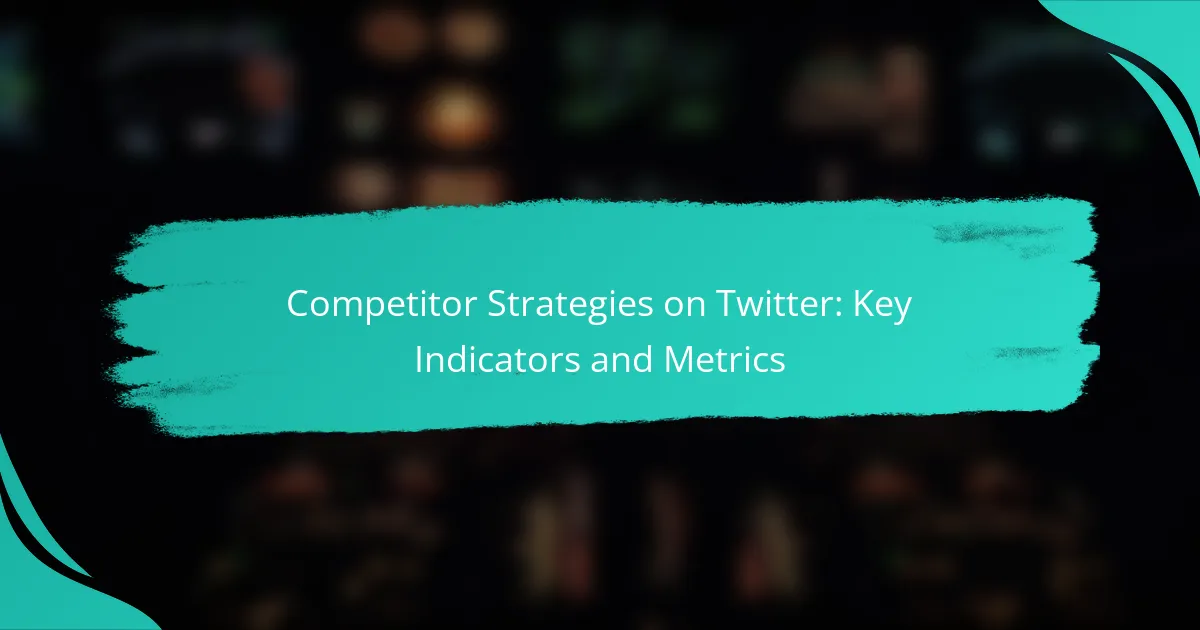Analyzing competitor strategies on Twitter is essential for understanding market dynamics and improving your own social media presence. Key metrics such as engagement rate, follower growth, and tweet frequency provide valuable insights into how effectively competitors connect with their audience. Utilizing specialized tools can enhance this analysis, allowing businesses to make informed, data-driven decisions based on competitor performance.

What are the key metrics for analyzing competitor strategies on Twitter?
Key metrics for analyzing competitor strategies on Twitter include engagement rate, follower growth, tweet frequency, hashtag performance, and content type analysis. These indicators help assess how effectively competitors are connecting with their audience and adapting their strategies.
Engagement rate
Engagement rate measures how actively users interact with a competitor’s tweets. This metric is calculated by dividing the total engagements (likes, retweets, replies) by the total impressions or followers, then multiplying by 100 to get a percentage. A higher engagement rate indicates a more compelling content strategy.
For effective analysis, consider engagement rates typically ranging from 0.5% to 3% as benchmarks. Look for patterns over time to identify which types of content resonate most with the audience.
Follower growth
Follower growth tracks the increase in a competitor’s Twitter followers over a specific period. This metric is crucial for understanding brand popularity and reach. A steady increase in followers often reflects successful marketing campaigns or viral content.
Monitor follower growth monthly or quarterly, aiming for a growth rate of around 5% to 10% as a healthy benchmark. Sudden spikes may indicate successful promotions or trending topics, while stagnation could signal a need for strategy adjustments.
Tweet frequency
Tweet frequency refers to how often a competitor posts on Twitter. Regular posting can keep a brand relevant and engaged with its audience. However, excessive tweeting may lead to audience fatigue.
Analyze tweet frequency by tracking the number of tweets per day or week. Aiming for 1 to 3 tweets per day is generally effective for maintaining visibility without overwhelming followers. Adjust frequency based on audience engagement and feedback.
Hashtag performance
Hashtag performance evaluates the effectiveness of hashtags used in tweets. Effective hashtags can increase visibility and engagement, while poorly chosen ones may hinder reach. Analyze which hashtags generate the most interactions and impressions.
To assess performance, track engagement metrics for specific hashtags over time. Aim to use 1 to 3 relevant hashtags per tweet to enhance discoverability without cluttering the message.
Content type analysis
Content type analysis examines the various formats of tweets, such as images, videos, polls, or text-only posts. Different types of content can yield varying engagement levels, and understanding these differences is vital for strategy refinement.
Review engagement metrics for each content type to identify what works best. For example, tweets with images or videos often see higher engagement rates compared to text-only posts. Experiment with a mix of content types to optimize audience interaction.
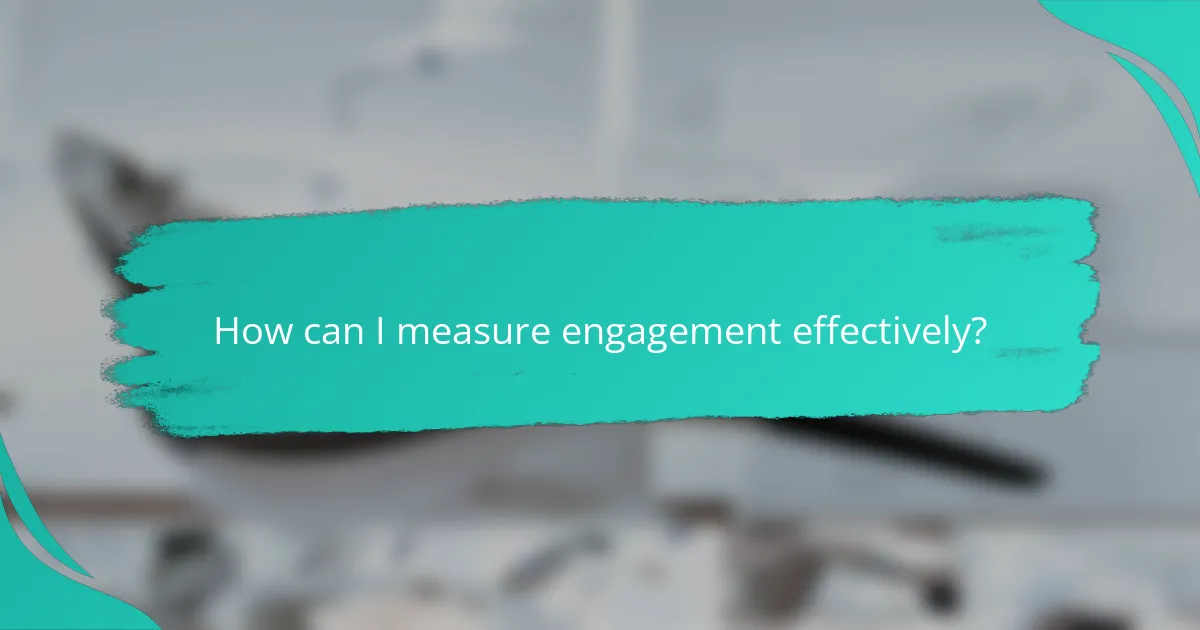
How can I measure engagement effectively?
Measuring engagement on Twitter involves tracking interactions such as likes, retweets, and replies to assess how well your content resonates with your audience. Effective engagement metrics provide insights into audience behavior and content performance, allowing for data-driven decisions.
Using Twitter Analytics
Twitter Analytics is a built-in tool that provides detailed insights into your account’s performance. You can track metrics like tweet impressions, engagement rates, and follower growth over time. This data helps identify which types of content generate the most interaction.
To access Twitter Analytics, simply log into your Twitter account and navigate to the “Analytics” section. Regularly reviewing these metrics can help you adjust your content strategy to improve engagement.
Third-party tools like Hootsuite
Third-party tools such as Hootsuite offer advanced analytics features that can complement Twitter’s native tools. These platforms often provide more comprehensive reports, allowing you to analyze engagement across multiple social media channels. You can track metrics like sentiment analysis and competitor performance.
When using Hootsuite, set up custom reports to focus on key engagement metrics relevant to your goals. This can help streamline your analysis and provide actionable insights for optimizing your Twitter strategy.

What tools are best for competitor analysis on Twitter?
Effective competitor analysis on Twitter can be achieved using several specialized tools that provide insights into engagement metrics, follower growth, and content performance. These tools help businesses understand their competitors’ strategies and improve their own social media presence.
BuzzSumo
BuzzSumo is a powerful tool for analyzing content performance on Twitter. It allows users to identify the most shared content and trending topics within their industry, providing insights into what resonates with audiences. By entering a competitor’s Twitter handle, you can see their top-performing tweets and the engagement they receive.
Consider using BuzzSumo to track specific keywords or hashtags relevant to your niche. This can help you discover content gaps and opportunities to create more engaging posts. However, be aware that while BuzzSumo offers a free trial, full access requires a subscription, which can range from moderate to high depending on the features you need.
Sprout Social
Sprout Social is a comprehensive social media management tool that includes robust competitor analysis features. It provides detailed reports on engagement metrics, audience demographics, and posting frequency for both your account and your competitors’. This data can help you benchmark your performance against industry standards.
Utilizing Sprout Social’s comparison reports can reveal trends in your competitors’ strategies, allowing you to adjust your approach accordingly. Keep in mind that Sprout Social operates on a subscription model, with pricing tiers that vary based on the number of profiles and features you require.
Followerwonk
Followerwonk specializes in Twitter analytics, focusing on follower insights and engagement metrics. This tool allows you to analyze your competitors’ followers, including their locations and bio keywords, which can inform your targeting strategies. By understanding who follows your competitors, you can tailor your content to attract similar audiences.
To maximize Followerwonk’s potential, use its “Compare Users” feature to evaluate multiple accounts side by side. This can help you identify strengths and weaknesses in your competitors’ follower engagement. Followerwonk offers both free and paid plans, with the paid version providing more in-depth analytics and features.
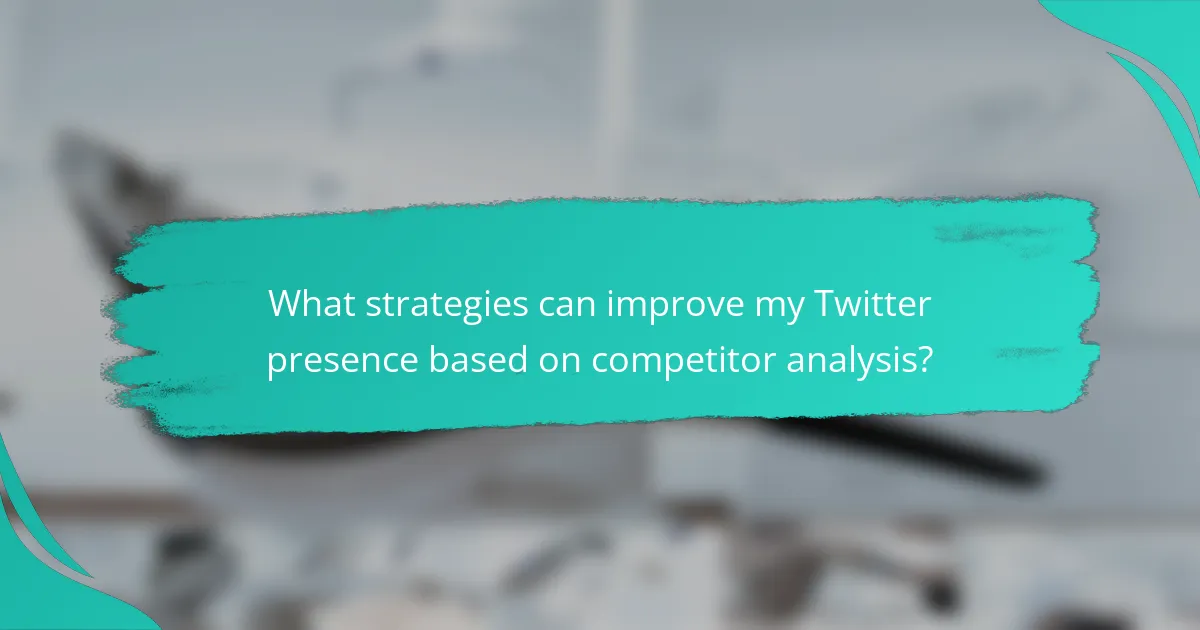
What strategies can improve my Twitter presence based on competitor analysis?
Improving your Twitter presence can be achieved by analyzing competitor strategies to identify effective practices. Focus on content optimization, targeted advertising, and engagement tactics to enhance visibility and interaction.
Content optimization
Content optimization involves tailoring your tweets to resonate with your audience while analyzing what competitors post. Look at the types of content that generate the most engagement, such as images, videos, or polls, and adapt your strategy accordingly.
Consider using relevant hashtags and keywords that align with trending topics in your industry. This can increase the likelihood of your tweets being discovered by users interested in similar content.
Targeted advertising
Targeted advertising on Twitter allows you to reach specific demographics based on interests, location, and behaviors. By studying your competitors’ ad campaigns, you can identify which audience segments are most responsive and tailor your ads to those groups.
Utilize Twitter’s analytics tools to track the performance of your ads and adjust your targeting parameters as needed. A/B testing different ad formats and messages can also help refine your approach and improve your return on investment.
Engagement tactics
Engagement tactics are essential for building a loyal following on Twitter. Analyze how competitors interact with their audience, such as responding to comments, retweeting user-generated content, or hosting Twitter chats.
Implement strategies like asking questions or running contests to encourage participation. Regularly monitor engagement metrics to understand what resonates with your audience and adjust your tactics to foster a more interactive community.
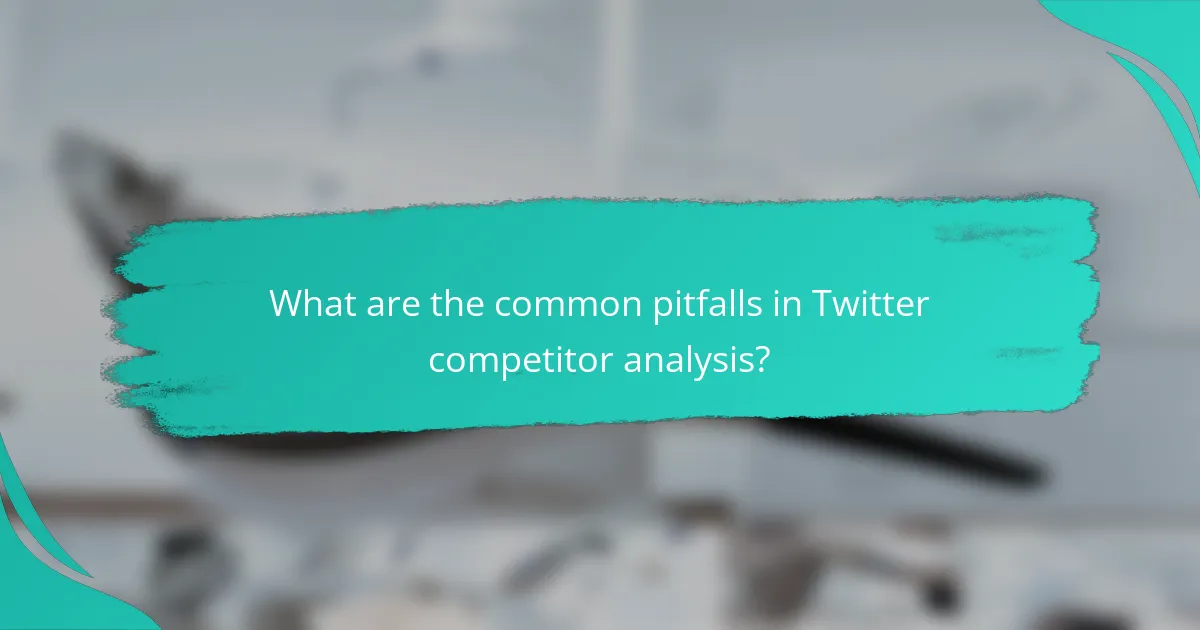
What are the common pitfalls in Twitter competitor analysis?
Common pitfalls in Twitter competitor analysis include overlooking audience demographics and placing too much emphasis on follower count. These mistakes can lead to misguided strategies that fail to resonate with target audiences.
Ignoring audience demographics
Understanding audience demographics is crucial for effective competitor analysis on Twitter. Factors such as age, gender, location, and interests can significantly influence engagement and content preferences. For example, a brand targeting millennials may focus on different messaging and content types compared to one targeting baby boomers.
To avoid this pitfall, analyze not just who follows your competitors, but also who engages with their content. Utilize Twitter analytics tools to gather insights on audience characteristics and tailor your strategies accordingly.
Focusing solely on follower count
While follower count can indicate popularity, it does not reflect engagement quality or audience loyalty. A competitor may have a large following but low interaction rates, suggesting that their audience is not genuinely interested. Instead, focus on metrics like retweets, likes, and replies to gauge true engagement.
Consider creating a balanced scorecard that includes follower count, engagement rates, and content performance. This approach will provide a more comprehensive view of a competitor’s effectiveness on Twitter and help you identify actionable insights for your own strategy.
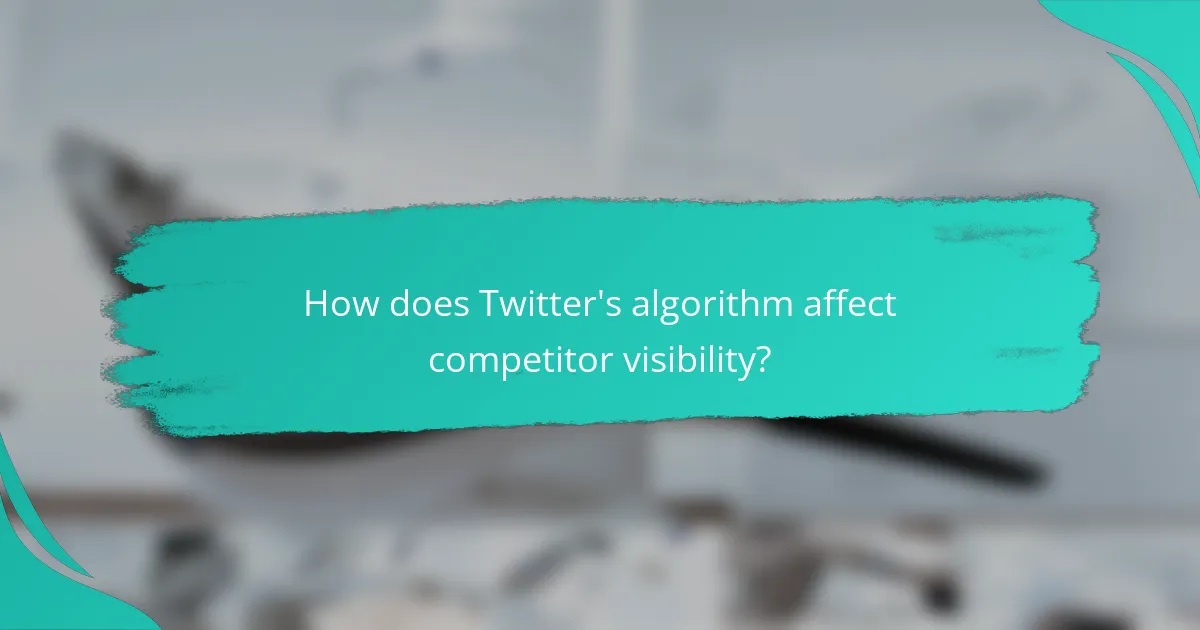
How does Twitter’s algorithm affect competitor visibility?
Twitter’s algorithm significantly influences how competitors are seen on the platform by determining which tweets are shown to users. It prioritizes content based on engagement, relevance, and recency, impacting visibility and reach for brands and competitors alike.
Engagement Metrics
Engagement metrics, such as likes, retweets, and replies, play a crucial role in how Twitter’s algorithm ranks tweets. Higher engagement often leads to increased visibility in users’ feeds, making it essential for competitors to create content that resonates with their audience.
To enhance engagement, competitors should focus on crafting compelling tweets that encourage interaction. This can include asking questions, using polls, or sharing eye-catching visuals. Regularly analyzing engagement data can help identify what types of content perform best.
Content Relevance
The algorithm assesses content relevance based on user interests and interactions. Tweets that align closely with a user’s past behavior are more likely to appear in their feed. Competitors should tailor their content to address the interests and needs of their target audience.
Using relevant hashtags and keywords can improve the chances of being discovered by users interested in specific topics. Competitors should research trending topics and incorporate them into their tweets to boost relevance and visibility.
Recency of Tweets
Recency is a key factor in Twitter’s algorithm, as it favors newer content over older posts. This means that competitors need to maintain a consistent posting schedule to ensure their tweets are timely and relevant.
Posting during peak engagement times, which can vary by audience, can enhance visibility. Competitors should experiment with different posting times and analyze engagement patterns to optimize their tweet timing.
